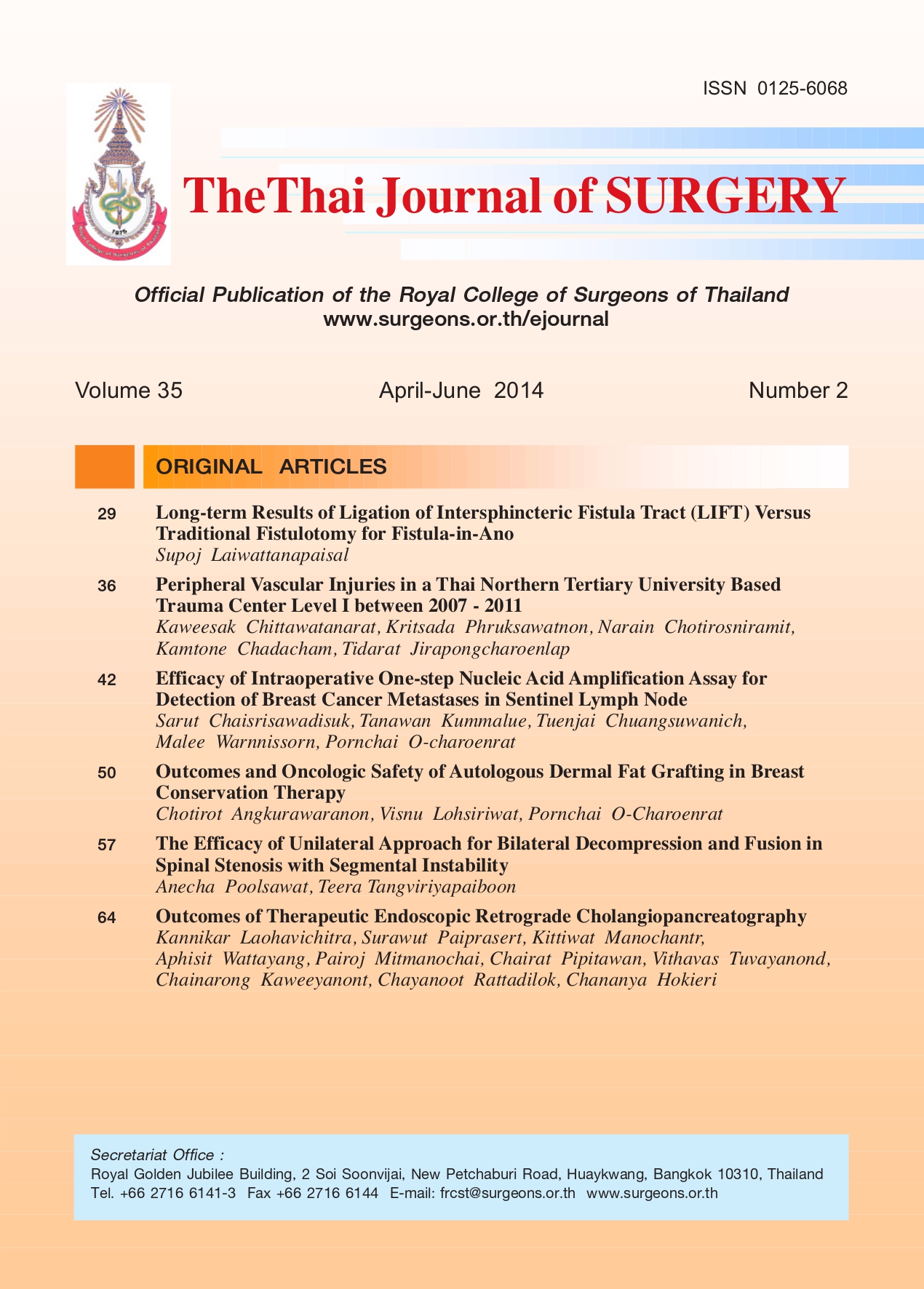Outcomes of Therapeutic Endoscopic Retrograde Cholangiopancreatography
Keywords:
Cholelithiasis, common bile duct stone, endoscopic balloon dilation, doscopic retrograde cholangiopancreatography, endoscopic sphincterotomyAbstract
Objective: To study the outcomes of therapeutic endoscopic retrograde cholangiopancreatography (ERCP)performed by one endoscopist focusing on results and complications of first biliary cannulation.
Methods: Two hundred and fifty nine consecutive therapeutic ERCP procedures were included in the study.
Patients were classified into three groups according to sphincterotomy techniques: (1) standard endoscopic
sphincterotomy (EST); (2) precut EST; (3) endoscopic balloon dilation (EPBD)/endoscopic large balloon dilation
(EPLBD). Characteristics of patients, indications for ERCP, number of instruments used, results and complications
were analyzed.
Results: ERCP for malignant biliary strictures and unintentional pancreatic duct injection were significantly
more frequent in the precut EST group compared with the standard EST group. The majority of patients in the EPBD/
EPLBD group had cholelithiasis, and required more instrumentation. Of the 259 cases, first biliary cannulation was
achieved by using standard sphincterotomy in 204 cases (79%). Immediate precut EST after failed standard cannulation
was successful in 46 of 50 cases (92%). The cumulative cannulation success rate was 97% (250 of 259). The precut EST
group had the highest complication rate (14%), which was not significantly higher than that in the standard EST group
(5%). The EPBD/EPLBD group had the lowest complication rate of 2%.
Conclusion: Malignant biliary obstruction may cause difficulty in biliary cannulation and may require the use of
the precut technique to achieve successful cannulation. Precut EST using both septotomy and needle knife techniques
could increase the rate of successful biliary cannulation in difficult cases without significantly increasing the risk of
complications. Early precut should be considered when facing with difficult cases to avoid over manipulation of the
papilla. EPBD/EPLBD was safe and effective for biliary cannulation and treatment of large CBD stones.
References
associated with the development of complications in patients
undergoing precut sphincterotomy: a prospective, controlled,
randomized, multicenter study. Am J Gastroenterol 2009;
104:2412.
2. Swan MP, Alexander S, Moss A, et al. Needle knife
sphincterotomy does not increase the risk of pancreatitis in
patients with difficult biliary cannulation. Clin Gastroenterol
Hepatol 2013;11:430.
3. Kahaleh M, Tokar J, Mullick T, et al. Prospective evaluation of
pancreatic sphincterotomy as a precut technique for biliary
cannulation. Clin Gastroenterol Hepatol 2004;2:971.
4. deWeerth A, Seitz U, Zhong Y, et al. Primary precutting versus
conventional over-the-wire sphincterotomy for bile duct
access: a prospective randomized study. Endoscopy 2006;
38:1235.
5. Cotton PB. Precut papillotomy–a risky technique for experts
only. Gastrointest Endosc 1989; 35:578.
6. Chan CH, Brennan FN, Zimmerman MJ, et al. Wire assisted
transpancreaticseptotomy, needle knife precut or both for
difficult biliary access. J Gastroenterol Hepatol 2012 ;27(8):
1293-7.
7. Catalano MF, Linder JD, Geenen JE. Endoscopic
transpancreatic papillary septotomy for inaccessible
obstructed bile ducts: Comparison with standard pre-cut
papillotomy. Gastrointest Endosc 2004;60(4):557-61.
8. Kapetanos D, Kokozidis G, Christodoulou D, et al. Case series
of transpancreaticseptotomyas precutting technique for
difficult bile duct cannulation. Endoscopy 2007;39:802-6.
9. Feng Y, Zhu H, Chen X, et al. Comparison of endoscopic
papillary large balloon dilation and endoscopic
sphincterotomy for retrieval of choledocholithiasis: a metaanalysis
of randomized controlled trials. J Gastroenterol
2012;47:655-63.
10. Cotton PB, Lehman G, Vennes J, et al. Endoscopic
sphincterotomy complications and their management: an
attempt at consensus. Gastrointest Endosc 1991;37:383-93
11. Attam R, Freeman ML. Endoscopic papillary balloon dilation
for stone extraction: if, when, and for how long? Gastrointest
Endosc 2012;72:1163-6
12. Ersoz G, Tekesin O, Ozutemiz AO, et al. Biliary sphincterotomy
plus dilation with a large balloon for bile duct stones that are
difficult to extract. Gastrointest Endosc 2003;57:156-9
13. Itoi T, Itokawa F, Sofuni A, et al. Endoscopic sphincterotomy
combine with large balloon dilation can reduce the procedure
time and fluoroscopy tome for removal of large bileductstones.
Am J Gastroenterol 2009;104:560-5
Downloads
Published
How to Cite
Issue
Section
License
Articles must be contributed solely to The Thai Journal of Surgery and when published become the property of the Royal College of Surgeons of Thailand. The Royal College of Surgeons of Thailand reserves copyright on all published materials and such materials may not be reproduced in any form without the written permission.



